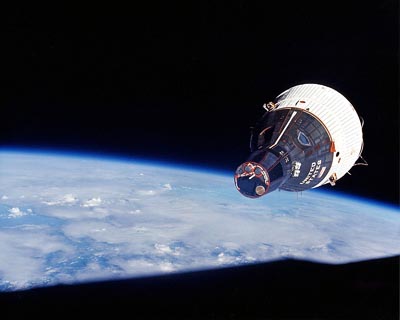 Gemini VII was launched 44 years ago on December 4, 1965. Commanding the flight was Jim Lovell, with Frank Borman as Pilot. Two things made this flight unique: at the time, it was the longest US spaceflight and remained so until the Skylab missions, and it was part of the first dual-spacecraft mission conducted by NASA. Scheduled for a 14 day stay in space, the Gemini crew members were to investigate long term spaceflight. An added bonus came when Gemini VI's Agena target vehicle crashed into the ocean shortly after liftoff. Rather than cancel the mission, VII became VI's target for rendezvous. It provided immeasurable experience to the mission control teams in handling two spacecraft simultaneously, a needed skill for the upcoming Apollo missions with its separate command and lunar modules. Photographically, it provided the first good images of a manned spacecraft in orbit. We are so used to seeing the shuttle or the space station floating in space we forget these images used to be the exception rather than the rule.
Gemini VII was launched 44 years ago on December 4, 1965. Commanding the flight was Jim Lovell, with Frank Borman as Pilot. Two things made this flight unique: at the time, it was the longest US spaceflight and remained so until the Skylab missions, and it was part of the first dual-spacecraft mission conducted by NASA. Scheduled for a 14 day stay in space, the Gemini crew members were to investigate long term spaceflight. An added bonus came when Gemini VI's Agena target vehicle crashed into the ocean shortly after liftoff. Rather than cancel the mission, VII became VI's target for rendezvous. It provided immeasurable experience to the mission control teams in handling two spacecraft simultaneously, a needed skill for the upcoming Apollo missions with its separate command and lunar modules. Photographically, it provided the first good images of a manned spacecraft in orbit. We are so used to seeing the shuttle or the space station floating in space we forget these images used to be the exception rather than the rule.For the rendezvous Gemini VII was the passive target, but the long duration flight provided the real challenges. Imagine spending two weeks with another person in an area the size of a bathroom stall and you'll get the idea. And you would have a toilet to use! For the crew of G-VII space was a premium. Packing enough food for the mission, and then where to place the trash, was a job for puzzle solvers. The crew practiced shoving trash behind their seats. They did not have the option of depressurizing their craft and opening a door to toss the stuff outside, as they wore a new long-duration spacesuit that was not made for such an event.
These new suits could be removed, even in the cramped quarters of the capsule, though mission rules only allowed one astronaut to doff his suit at a time. After five days, NASA relented and allowed both men to remove their pressure suits. Although much more comfortable, the chore to stash the suits so as not to interfere with spacecraft operation became a new challenge.
After a week, the novelty of spaceflight wore off. The crew was allowed free time, an unthinkable thing for previous flights. They took to reading books they packed for the time: Borman reading Roughing It by Mark Twain, and Lovell reading Drums Along the Mohawk by Walter D. Edmonds.
Recovery came on the fourteenth day with a flawless use of the retro rockets, and found the spacecraft had landed in the Pacific just 11.8 kilometers from the recovery ship, the USS Wasp. The astronauts were a little week from their time in microgravity, but were able to stand and greet the naval crew that recovered them. The spacecraft spent time at Johnson Space Center under investigation for it's long term in space, and then was turned over to the Smithsonian's National Air & Space Museum. For several years it was suspended in the second floor hall of space exploration, but has since been moved to a new display area near the Space Shuttle Enterprise at the Stephen F. Udvar-Hazy Center. There it is displayed without doors, enclosed in a plexiglas envelope to allow a good view of the interior.
For paving the way for future flights to the moon and our first long duration mission in space, Gemini VII is this week's Spacecraft of the Week.






